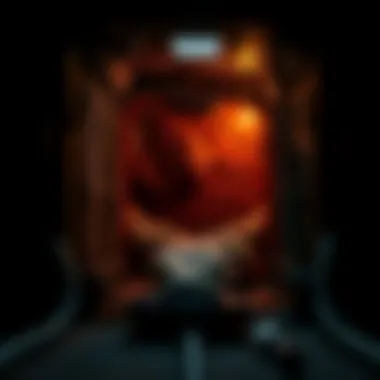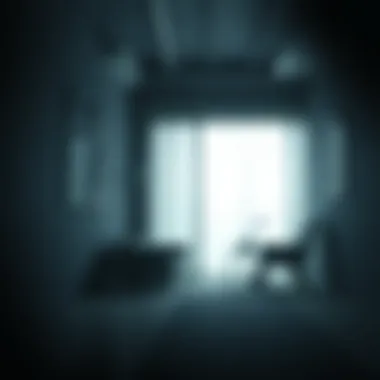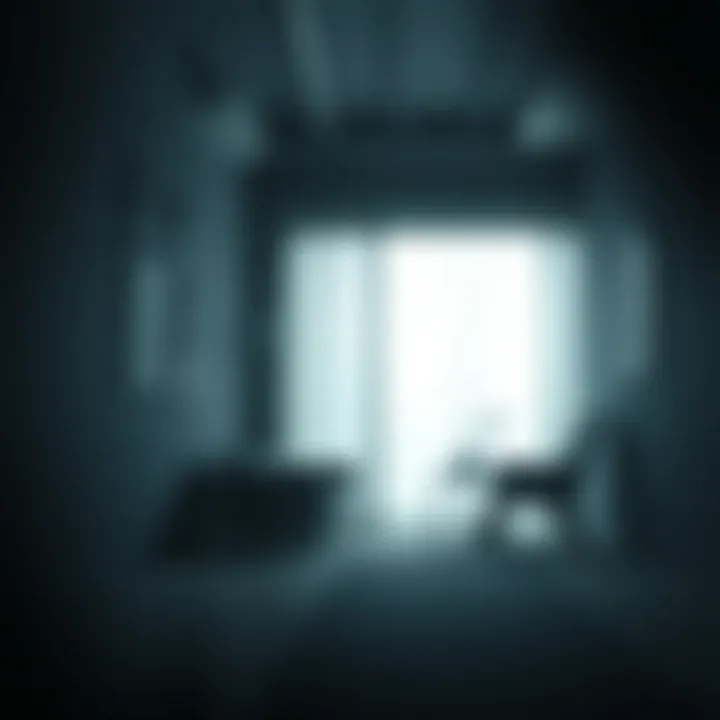Understanding Claustrophobia: Fear of Enclosed Spaces


Intro
Claustrophobia, a term that may seem daunting to some, draws its roots from the Latin word "claustrum," meaning barrier, and the Greek word "phobos," which stands for fear. People dealing with claustrophobia feel an overwhelming sense of panic at the thought or experience of being in tight or enclosed spaces. This article aims to peel back the layers of this specific phobia, delving into its psychological and physiological facets, as well as its triggers, coping mechanisms, and treatment options.
Understanding Mental Health and Well-being
Mental health is a crucial component of our overall well-being. It encompasses emotional, psychological, and social factors that influence our thoughts, feelings, and actions. Just like physical health, mental health requires nurturing to thrive.
What is Mental Health?
Mental health refers to a person’s emotional, psychological, and social well-being. It's the foundation upon which we build our lives. Mental strength helps us navigate stresses, connect with others, and make choices reflecting our values.
The Importance of Prioritizing Mental Well-being
Prioritizing mental health is not just a fad; it's essential for a fulfilling life. Just as folks wouldn’t disregard a physical ailment, ignoring mental distress can lead to severe consequences. Taking a proactive approach to mental well-being can enhance resilience and overall quality of life.
Common Mental Health Challenges and Disorders
Some common mental health challenges include anxiety disorders, depression, and, of course, specific phobias like claustrophobia. Understanding these challenges can foster a supportive environment, encouraging individuals to seek help when needed.
"Mental health is not a destination, but a process. It's about how you drive, not where you're going."
Strategies for Improving Mental Health
Improving mental health is a journey that can take various forms. Simple but effective strategies often yield significant results in enhancing emotional well-being.
Self-care Techniques and Practices
Self-care isn't just about bubble baths and face masks; it encompasses practices aimed at preserving or improving one’s health. Activities such as journaling, engaging in hobbies, or even taking mindful walks in nature can provide an escape from the role of daily worries.
Building Resilience and Stress Management
Resilience can be likened to a mental rubber band. It’s the ability to spring back from hardship. Techniques that support resilience include maintaining a positive outlook, reframing negative thoughts, and developing strong support networks.
Seeking Professional Help: Therapy and Counseling
There’s no shame in seeking help. Professional therapy, such as Cognitive Behavioral Therapy (CBT), has proven effective in treating claustrophobia. Trained therapists can guide individuals in understanding their fears and developing coping strategies to manage them.
Finding Balance in Life
Striking a balance is like juggling; one wrong move can send everything crashing down. Maintaining a healthy lifestyle can significantly affect mental well-being.
Healthy Lifestyle Choices: Diet, Exercise, and Sleep
A balanced diet, regular physical activity, and adequate sleep play a pivotal role in maintaining mental health. Nutritious foods fuel the body and brain, while exercise releases feel-good hormones. Establishing a sleep routine can help regulate mood.
Mindfulness and Meditation Practices
Mindfulness practices, including meditation and yoga, help ground individuals in the present moment. These practices can reduce anxiety and create a sense of calm, especially for someone experiencing panic from claustrophobia.
Setting Boundaries and Managing Time Effectively
Effective time management and clear boundaries with work and relationships can alleviate unnecessary stress. Learning to say no or delegate tasks can be crucial steps toward achieving balance.
Enhancing Personal Development
The journey of personal development is ongoing. Engaging in activities that foster growth can reshape one's outlook and approach to life's challenges.
Goal Setting and Productivity Tips
Setting realistic goals can provide direction and purpose. Breaking down goals into smaller, manageable tasks boosts motivation, making the larger goal seem less daunting.
Building Healthy Relationships and Social Connections
Connections with others are vital. Engaging in activities that encourage relationships can create a support system that aids in personal and mental growth.
Practicing Gratitude and Positivity
Simple practices, like maintaining a gratitude journal, can shift focus from what’s wrong to what’s right. Cultivating a habit of appreciation can have profound effects on overall mood and perspective.
Tips for Maintaining Mental Well-being
Continual effort is essential for maintaining mental health. Strategies can help individuals navigate through lean times and thrive.
Strategies for Preventing Burnout
Recognizing the signs of burnout – exhaustion, cynicism, and decreased performance – is crucial. Awareness allows for timely intervention.
Coping with Challenges and Setbacks
Life is full of ups and downs. Developing flexible coping strategies can create a buffer against stress and uncertainty. Understanding that setbacks are a part of life is vital in preventing them from steering one off course.
Creating a Supportive Environment
Surrounding oneself with positivity can work wonders. Creating an environment where one feels safe and valued nurtures mental health and encourages healing.
By diving deep into the dimensions of claustrophobia and understanding its connections to overall mental health, individuals can begin to navigate their fears. Understanding the complexities of one's mind can often pave the way to recovery and ultimately, improved well-being.


Defining Claustrophobia
Claustrophobia, a term that resonates with many, frames our exploration into the complicated landscape of fear associated with enclosed spaces. Understanding this particular phobia is crucial for both individuals who experience it and for those who aim to support them. By unpacking its definition, we delve deeper into the psyche of fear, validation of experiences, and pathways to overcoming this formidable challenge.
Historical Context of Claustrophobia
The roots of claustrophobia can be traced back through history, often reflecting broader societal anxieties. Historically, enclosures have been used in various contexts—dungeons, prisons, and even the confinement experienced during warfare. Ancient civilizations like the Romans and Greeks encapsulated the concept of fear in their stories, often portraying the confinement of heroes or citizens as a significant narrative device.
One might find it intriguing that in the 19th century, with the burgeoning of urbanization and the introduction of new modes of transportation like trains and elevators, the perils of constrained spaces became embedded in the collective consciousness. Fast-forward to the present, where our everyday lives involve interactions with confined environments of all sorts, from office cubicles to airplane cabins. An historical lens reveals how this fear is not just a personal struggle, but a societal phenomenon shaped by time and context.
Clinical Definition and Symptoms
In clinical parlance, claustrophobia is defined as an intense, irrational fear of crowded or confined spaces. This can manifest in a variety of ways, impacting individuals with different severity levels. Some might feel a sense of unease in a crowded elevator, while others may experience overwhelming panic in a small room.
Recognizing the symptoms is key—individuals typically report:
- Rapid heartbeat
- Shortness of breath
- Sweating
- Dizziness
- Feelings of losing control
- Nausea
The above indicators are not just physical reactions; they can spiral into emotional turmoil, leading to avoidance behaviors. These symptoms can severely limit an individual’s daily activities and overall quality of life, making it paramount to discuss and understand claustrophobia thoroughly.
"Claustrophobia is more than a fear; it’s a barrier that can confine one's life to limitations woven by anxiety."
In summary, defining claustrophobia lays the groundwork for an expansive understanding of fear's psychological and physiological dimensions. By exploring its historical context, we can grasp how deeply rooted this fear is in both individual experience and cultural narrative. A keen awareness of clinical definitions and common symptoms further equips individuals and loved ones to address this significant mental health concern.
Exploring the Psychological Roots
Understanding the psychological roots of claustrophobia is crucial, as it sheds light on how the mind and environment intertwine to shape our fears. This section aims to peel back the layers that contribute to this phobia, exploring the factors that intertwine with our genetic makeup and life experiences. It’s not merely about recognizing symptoms; it’s about understanding their foundational elements that can lead to more effective coping strategies and treatments.
The Role of Genetics
Genetics is often seen as the silent puppeteer behind many psychological conditions, including claustrophobia. Studies suggest a tendency for anxiety disorders, including phobias, to run in families. Some individuals may inherit a predisposition through genetic pathways affecting neurotransmitter function and brain chemistry. For instance, a family history of anxiety may indicate a higher likelihood of developing claustrophobic tendencies.
While the genetic component isn't the sole factor, it plays a significant role. Those with a background of anxiety disorders might find themselves more susceptible to fears and phobias. A solid understanding of genetic influences can open avenues for early intervention.
Environmental Factors and Early Experiences
Our surroundings and life experiences leave deep imprints on our psyches. Often, claustrophobia can be traced back to certain environmental incidents or childhood experiences. A sudden incident, like being trapped in a small space or being in proximity to fearful situations, can lead to heightened anxiety about similar environments later in life.
- Childhood Trauma: When a child experiences confinement or restraint under distressing circumstances, it can create long-lasting psychological effects. The memory of that fear might resurface as an adult, manifesting in claustrophobic reactions.
- Observation and Modeling: If children witness a parent or guardian struggle with enclosed spaces, they may unconsciously adopt similar fears. The role of observation as an influential teaching mechanism cannot be overstated.
- Cultural Aspects: Different cultures may have varying perceptions of confined spaces, contributing to how an individual perceives and reacts to these environments.
Recognizing the environmental triggers and early experiences that contribute to claustrophobia's development could guide individuals to address these fears more deeply and successfully.
The Impact of Stress and Anxiety
Stress and anxiety permeate our lives, often setting the stage for various issues, including phobias. Understanding how they interact with claustrophobia is vital for effective treatment. High levels of stress can amplify feelings of fear, making previously manageable situations feel overwhelming.
- Cyclical Nature of Anxiety: Anxiety can create a feedback loop where the fear of having a claustrophobic episode causes further anxiety, intensifying the likelihood of another episode. This cycle is destructive, as it prevents individuals from breaking free from the confines of their fears.
- Stress Management Techniques: Developing coping strategies that address stress, such as breathing exercises or mindfulness, can help in reducing overall anxiety levels. These practices can empower individuals to regain control during challenging moments.
Understanding this psychological framework opens up numerous paths for individuals grappling with claustrophobia. Through acknowledging the intertwining forces of genetics, environmental factors, and the impact of stress, there’s potential for transformative healing. This insight not only equips individuals facing claustrophobia but also fosters a deeper empathy for the challenges they endure.
"The understanding of one’s fears is the cornerstone to mastering them."
For further reading on psychological aspects of phobias, visit Wikipedia or Britannica. Learning about these roots can pave the way for practical coping strategies and effective therapeutic approaches.
Common Triggers of Claustrophobia
Understanding the common triggers of claustrophobia is essential, as these elements often serve as the very catalyst that sparks intense fear in individuals. Identifying specific triggers helps not only in acknowledging this phobia but also in developing coping strategies. It's key to delve into the physical environments that amplify this fear alongside the psychological factors that plant the seeds of anxiety in individuals.
Physical Environments Leading to Fear
Elevators
The prospect of being inside an elevator can unsettle many, and the discomfort is often tied to the sheer lack of control. Elevators, by design, are small compartments that transport people from one floor to another. They symbolize an enclosed space where movement is limited, inducing claustrophobic responses in vulnerable individuals. One significant characteristic of elevators is the enclosed nature, providing little opportunity for escape when panic sets in. The confined four walls and the incessant hum of machinery can create a sense of entrapment.
Elevators, though a crucial part of modern architecture, can provoke overwhelming anxiety for individuals facing this phobia. The unique feature lies in their mechanical dependency; if the system malfunctions, it can escalate feelings of helplessness. This situation enhances the fear factor, making elevators a common trigger not just in theory, but in real-life contexts.
Subways
Traveling underground in a subway can be a daunting thought for those who experience claustrophobia. Subways are characterized by confined spaces and crowded environments, which can be problematic for someone struggling with this fear. The sight of a train approaching, coupled with the rush of passengers, can heighten anxiety levels, leading to feelings of being trapped as one boards the narrow compartments.
Subways present a unique challenge as they blend the physical constraints of space with the psychological pressure of crowd dynamics. The sheer number of strangers, coupled with the loud noises, can make this public transport option particularly harrowing. For many, the thought of navigating through dark tunnels without immediate access to exit points can act as a strong psychological trigger, making subways another prime example for this article.
Tight Spaces
Tight spaces encompass any area where mobility is substantially restricted. These can range from small rooms to tightly packed queues. The essence of tight spaces is their intense limit on physical freedom, which often aligns with a heightened sense of vulnerability. Individuals frequently report that the sight of a cramped area instantly triggers an overwhelming sense of panic, leading to the fight or flight response.
One characteristic of tight spaces is their diverse nature; they can be both physical structures and psychological settings. This dual characteristic adds complexity to the experience of claustrophobia. The issue, however, lies in how quickly that sense of confinement can weave its way into someone’s daily life, affecting social interactions and personal well-being.
Psychological Triggers
Anticipation of Confinement
Anticipating confinement can be a powerful psychological trigger for individuals with claustrophobia. This involves not merely experiencing a confined space but fearing the thought of it beforehand. The role of anticipatory anxiety in claustrophobia is crucial; it builds up an emotional response long before the individual even encounters the feared situation. This mental preparation can lead to avoidance behaviors, further complicating one’s life and interactions.
By labeling such anticipatory thoughts as damaging, individuals can start to dismantle their perceptions, which can lead to a freer, less anxious mind.
Previous Trauma


Previous trauma is often at play in the background of a person's experience with claustrophobia. Whether it’s an event like being stuck in a small space or another emotionally charged situation, previous trauma lays a foundation for present fears. Such experiences often have lasting impacts, influencing how someone approaches confined spaces and environments.
Understanding how these past incidents feed present anxieties is vital. This insight allows individuals to see that their responses may arise more from historical context than the current circumstances. Recognizing these triggers, while daunting, paves the way for healing and understanding, encouraging a stronger grip on personal experiences.
The connection between past experiences and present fears often creates intricate layers in the understanding of claustrophobia, making awareness a key component in addressing this phobia.
By peeling back the layers of claustrophobia’s common triggers—both physical and psychological—individuals and those supporting them can cultivate a deeper comprehension, which is paramount in navigating this complex fear.
Physiological Responses to Claustrophobia
Claustrophobia is not just a matter of psychological sensation; it involves a cascade of physiological responses that can deeply impact the experiences of those who suffer from this phobia. Understanding these reactions is crucial, as it can help individuals recognize and manage their conditions more effectively. The body’s response to claustrophobic situations can shape how one reacts emotionally and mentally, making it vital to comprehend.
Fight or Flight Mechanism
The fight or flight mechanism is an instinctual reaction that arises when confronted by danger or perceived threats. In claustrophobia, this physiological response can be triggered at the simple thought of being in a confined space. The body's systems go into overdrive, leading to a mixture of adrenaline rush and increased awareness. This heightened state can either urge a person to escape from the situation or confront it head-on.
An interesting aspect of this mechanism is that it’s not limited to physical threats—emotional and psychological triggers can set it off just as easily. For someone experiencing claustrophobia, the mental image of being trapped can prompt the same adrenaline surge as actually being confined. Understanding this can help victims of this phobia to develop more effective coping strategies, giving them the control they often feel has been stripped away when these episodes occur.
Symptoms Experienced During Episodes
The experience of claustrophobia goes hand in hand with a range of physical symptoms. These symptoms can not only escalate the feeling of panic, but they also contribute to a cycle that reinforces the fear. Addressing each symptom can lead to better management techniques, allowing individuals to regain a semblance of normalcy in situations that typically provoke fear.
Panic Attacks
Panic attacks are often a hallmark of claustrophobia. Characterized by a sudden onset of intense panic, these episodes can leave individuals feeling as if they are losing control. The rapid heartbeat, dizziness, and a sense of impending doom manifest vigorously, resembling a heart attack in intensity. Panic attacks can be particularly troublesome because they may occur unexpectedly, often in situations where help might not be readily accessible.
What makes panic attacks particularly noteworthy in this context is that they can reinforce claustrophobic feelings. The fear of experiencing another panic attack can lead to avoidance of situations where individuals feel trapped. Hence, they become entangled in a cycle that reinforces their fears. Recognizing panic attacks as a symptom rather than a defining characteristic is crucial for effective treatment.
Increased Heart Rate
During episodes of claustrophobia, an increased heart rate is a common physiological reaction. Much like how a deer might bolt when it senses danger, someone suffering from claustrophobia may feel their heart racing as a result of impending panic. This racing heartbeat not only contributes to the feeling of fear but can trick the body into an even more heightened state of alertness, ready to escape a situation that feels threatening.
What’s particularly significant about an increased heart rate is that it can become a self-fulfilling prophecy. When individuals notice their heart racing, they can become more anxious, which will further elevate their heart rate. Understanding this connection helps individuals work toward calming techniques before their heart rate escalates, ultimately letting them gain a foothold over their fear.
Hyperventilation
Hyperventilation is another physiological response that can occur during claustrophobic episodes. This occurs when an individual breathes rapidly and deeply, often leading to feelings of lightheadedness or even fainting. Hyperventilation can be alarming, sometimes compounded by an overwhelming feeling of helplessness in the situation. Despite its unintentional nature, this response can spin into a vicious cycle, exacerbating feelings of panic and fear.
What makes hyperventilation particularly relevant is its ability to distort one’s breathing pattern and create a sense of losing touch with reality. Individuals who can recognize this state may find it easier to remain grounded. Developing breathing techniques and learning to focus on the breaths can assist in managing not just hyperventilation but the entire claustrophobic experience. By understanding these physiological manifestations, individuals can take practical steps toward calming themselves down, reclaiming control in an otherwise uncontrollable situation.
It’s essential to remember that recognizing these physiological responses is the first step toward effective management. Each response presents an opportunity to educate oneself about the body's intricate workings and how to navigate the fears associated with claustrophobia.
Coping Strategies for Overcoming Claustrophobia
Coping strategies for overcoming claustrophobia are essential for individuals seeking relief from this often debilitating fear. The significance of having effective coping mechanisms cannot be overstated, as they equip a person with tools to manage anxiety in confined spaces. These strategies range from simple breathing exercises to more structured therapeutic approaches, allowing individuals to navigate their fears with a sense of control and resilience.
Each strategy presents its own set of benefits and considerations, creating a tailored approach to overcoming claustrophobia. By incorporating these techniques into daily life, individuals can gain confidence in facing their fears, ultimately enhancing their overall well-being.
Breathing Techniques
Breathing techniques are one of the first lines of defense against panic. They focus on regulating one’s breath to help calm the mind and body. When anxiety strikes, typical responses often include rapid and shallow breathing, which can exacerbate feelings of fear. Below are a few effective methods:
- Deep Breathing: Inhale deeply through the nose for a count of four, hold for four, and then exhale through the mouth for a count of six. This method slows the heart rate and encourages relaxation.
- Box Breathing: A technique commonly used in meditation, inhale for a count of four, hold for four, exhale for four, and hold again for four, creating a ‘box.’ This technique can bring about a sense of stability and control.
Implementing these practices on a routine basis may significantly reduce stress levels during episodes of claustrophobia. It’s not just about breathing but doing so mindfully, which taps into the brain's relaxation response.
Cognitive Behavioral Strategies
Cognitive Behavioral Therapy (CBT) offers structured approaches to dismantling the irrational beliefs associated with claustrophobia. This method helps individuals recognize distorted thought patterns and replace them with rational alternatives. Key elements of CBT could include:
- Identifying Triggers: Keeping a journal to note down situations that trigger anxiety, allowing individuals to prepare for them effectively.
- Challenging Negative Thoughts: Training oneself to question the validity of fearful thoughts can weaken their grip. Phrases like, "What evidence do I have that this will happen?" can be beneficial.
- Positive Affirmations: Using affirmations like "I am safe" can help foster a positive mindset when confronting fears.
These strategies require consistent practice, but once integrated into daily life, they can buffer against anxiety, leading to a healthier response to fear-inducing situations.
Gradual Exposure Therapy
Gradual Exposure Therapy is a nuanced approach rooted in the principle of desensitization. It involves gradually exposing individuals to their phobic stimuli in controlled doses until they can cope without significant fear.
- Step-by-step Exposure: Start with a scenario that triggers mild anxiety and progressively move toward more challenging situations. For instance, if elevators induce fear, one might begin by standing near an elevator before gradually riding it.
- Mindful Reflection: After each exposure, reflecting on the experience can bring insights into the irrational nature of fears, fostering empowerment.
- Setting Realistic Goals: It’s crucial to set achievable milestones that don't overwhelm the individual, creating a sense of accomplishment along the way.
This therapeutic technique often yields positive results for those committed to the process, offering a pathway towards reclaiming personal freedom from the limitations imposed by claustrophobia.
Utilizing these coping strategies can be a worthwhile endeavor for those living with claustrophobia, providing the means to regain control over their fears, enhancing both their daily experiences and overall quality of life.
Therapeutic Approaches to Treatment
When grappling with claustrophobia, understanding therapeutic approaches to treatment offers a beacon of hope for those affected. The right treatment can not only alleviate the suffocating grip of anxiety but also pave the way for a more fulfilling life. There are various strategies that can assist individuals in managing their phobia effectively, and the integration of multiple approaches often yields the best outcomes.
Talk Therapy
One of the most recognized methods in addressing claustrophobia is talk therapy, specifically cognitive behavioral therapy (CBT). Within this framework, patients engage in dialogue with trained therapists to challenge and reframe negative thoughts related to their enclosed space fears. In many cases, a safe space is created in therapy where individuals can explore their feelings without judgment.
Through CBT, patients may also learn how to react differently in situations that trigger their claustrophobia. Techniques such as systematic desensitization introduce controlled exposure to feared environments gradually. This kind of therapy helps in dismantling the negative associations tied to confined spaces, fostering a sense of empowerment and control.
"The only thing we have to fear is fear itself." - Franklin D. Roosevelt
Medication and Its Role


In some circumstances, therapy alone may not suffice to completely tackle claustrophobia. This is where medication comes into play as a useful adjunct. Antidepressants and anti-anxiety medications can assist individuals in managing their symptoms more effectively. Selective serotonin reuptake inhibitors (SSRIs) and benzodiazepines are often prescribed during the initial treatment phase to help lower anxiety levels.
However, it's essential to note that medication isn't a silver bullet. While it can help manage symptoms, it does not address the underlying fears or beliefs. Therefore, it's usually recommended to use medication in combination with therapy for the best results. Individuals should always consult with a healthcare professional to evaluate risks and benefits associated with medication.
Mindfulness and Relaxation Techniques
Mindfulness and relaxation techniques have garnered attention in recent years, especially as adjunct therapy to more traditional methods. These practices encourage individuals to focus on the present moment, thus pulling their thoughts away from anxious predictions about potential confinement. Techniques such as deep breathing, progressive muscle relaxation, and guided imagery can help ground individuals and reduce the physiological symptoms of anxiety.
Incorporating mindfulness into daily routines can also build resilience over time. Simple exercises such as meditative breathing or mindful walking help individuals cultivate a sense of calm, making it easier to confront their fears when they arise. Moreover, these practices create a toolbox of strategies that can be employed in moments of distress.
To sum up, while each therapeutic approach has its strengths, a combination of talk therapy, medication, and mindfulness techniques may provide a comprehensive path to managing claustrophobia. It highlights the importance of a personalized treatment plan tailored to individual needs.
For further support, resources are available through organizations like the National Institute of Mental Health and various mental health support communities on platforms such as Reddit. Ultimately, understanding the multifaceted nature of treatment can empower affected individuals to take charge of their mental health.
The Impact of Claustrophobia on Daily Life
The repercussions of claustrophobia stretch far beyond the immediate sense of unease when encountering tight spots. It's like carrying a heavy backpack laden with rocks, each representing a different aspect of life that gets affected. The importance of discussing the impact of claustrophobia on daily life lies in its profound effects on social interactions, career opportunities, and overall quality of life. Understanding these implications can help individuals not only confront their fears but also find effective ways to manage and mitigate them.
Social and Professional Implications
Claustrophobia can gnaw away at one's social life like a persistent rat in a quiet attic. Attending gatherings, entering crowded places, or engaging in activities that involve confined spaces can become daunting endeavors. This can lead many to avoid social situations altogether, leading to feelings of isolation or anxiety. Those grappling with claustrophobia may miss out on events or relationships due to the fear of being in confined spaces, impacting friendships and family ties.
In the professional realm, the stakes are equally high. Consider someone who has to use an elevator regularly in a high-rise building. For that person, the simple act of commuting to work might transform into a daily ordeal filled with dread. The fear of being trapped can affect career choices, where individuals might shy away from roles that require travel or lead to places with limited escape routes. Here are a few examples to illustrate this:
- An office worker might refuse a promotion that requires moving to the penthouse floor of a tall building.
- A student might avoid particular academic programs or fields that necessitate group outings, leading to missed opportunities.
- Professionals might not network effectively, avoiding conferences or events that typically involve enclosed spaces, hindering their career growth.
Quality of Life Considerations
Quality of life is a multi-layered term, encapsulating everything from personal happiness to overall well-being. Claustrophobia can infiltrate multiple facets of this, often manifesting in both physical and emotional distress. For instance, an individual with this phobia may experience symptoms such as panic attacks and excessive sweating during situations that trigger their fear, which can detract from everyday joy. Here are a few considerations:
- Freedom of Movement: The constant anxiety about entering tight spaces can lead to self-imposed limitations, reducing one’s freedom to enjoy everyday activities. Simple tasks like riding in a car during traffic or getting on a public bus can become sources of stress.
- Mental Well-being: Living with this persistent fear can foster feelings of frustration and helplessness. The added mental load can lead to increased anxiety, depression, and possibly other mental health issues if not addressed.
- Physical Health: As stress takes a toll, the physical health can also deteriorate. Increased heart rate and constant tension may result in headaches or gastrointestinal problems, feeding into a cycle where the fear itself exacerbates physical symptoms.
Understanding these impacts is essential. It paves the way for individuals to seek help, whether through therapy, support groups, or self-help resources available online. By acknowledging the weight that claustrophobia can have on various aspects of life, individuals may take steps toward finding freedom from their fears.
"Acknowledging the burden of claustrophobia is the first step in lightening the load."
In summary, recognizing the social and professional implications alongside the quality of life considerations can inspire those affected to confront their fears head-on. Through awareness and support, one can reclaim the joy that comes with living life fully.
Finding Support and Resources
Finding support when dealing with claustrophobia can be a game changer. This condition, while often isolating, does not have to be faced alone. There is a wealth of resources to explore, including support groups, online communities, and professional therapy options. These avenues offer individuals not just a lifeline but also camaraderie. They connect people who understand the anxiety and fears that come with enclosed spaces. By discovering and leveraging these resources, individuals can develop coping strategies that fit their personal experiences and needs.
Support Groups and Online Communities
Support groups provide an invaluable space for those grappling with claustrophobia. These gatherings allow individuals to share their experiences, find reassurance, and learn from others. The atmosphere often becomes a safe haven, free from judgments and filled with empathy. Participants can find comfort in stories that resonate with their own struggles, realizing they aren't navigating this journey in solitude.
Additionally, the rise of online communities has opened new doors for support. These digital platforms enable people to connect 24/7, making them particularly vital for those who may feel uncomfortable or unable to participate in physical groups. Websites, forums, and social media platforms such as Reddit or Facebook host countless discussions on the topic. In these spaces, members often share tips, personal victories, and resources that have aided in their own battles with claustrophobia.
While finding these groups, it's essential to check their credibility. Preferably, look for ones staffed by mental health professionals or those linked to established organizations. This not only ensures the advice given is sound, but also enriches the community with informed perspectives.
"A community formed of shared experiences can be more comforting than any textbook solution."
Benefits of Support Groups and Online Communities
- Shared Experiences: Connecting with others who share similar fears can reduce the sense of isolation.
- Emotional Stability: Sharing stories often leads to emotional release and understanding.
- Access to Resources: Members frequently exchange information about effective coping strategies and treatment options.
- Motivation: Hearing about others’ successes can inspire personal progress.
Professional Therapy Options
Navigating claustrophobia can be daunting, and sometimes it's essential to seek professional help. Therapists provide tailored strategies and can guide individuals through the emotional complexity associated with this phobia. Different therapies, such as cognitive-behavioral therapy (CBT), expose individuals to their fears in controlled ways, helping them develop healthier thought patterns and responses.
Medication may also be part of the treatment plan, particularly in cases where anxiety is severe. Prescription options may include selective serotonin reuptake inhibitors (SSRIs) or benzodiazepines, which can help alleviate symptoms during therapy. However, medication should always be managed by a qualified healthcare professional, ensuring it's appropriate for the individual's specific needs.
Individuals seeking therapy should look for professionals who specialize in anxiety disorders or phobias. Organizations like the American Psychological Association (apa.org) provide directories where one can find qualified therapists. Recommendations from trusted friends or family can also point individuals toward practitioners who have made a positive impact on others.
Key Considerations for Choosing Professional Therapy
- Specialization: Look for therapists who specialize in anxiety disorders.
- Approach: Ensure their therapeutic approach aligns with personal comfort levels.
- Accessibility: Consider location and availability to ensure regular attendance.
- Cost: Be aware of insurance coverage or potential out-of-pocket costs.
By understanding the available support systems, individuals grappling with claustrophobia can navigate their fears with greater ease. It’s crucial to take that first step and explore the network of support that exists. Whether through community gatherings or professional guidance, help is accessible, waiting to be discovered.
Looking Ahead: Future Research Directions
The exploration of claustrophobia continues to deepen with advancements in psychological science and neuroscience. As we move forward, it is essential to recognize the growing relevance of this field, not only for those who suffer from this specific phobia but also for mental health professionals who facilitate recovery. This section highlights the need for ongoing research and provides insights into potential future directions that could significantly enhance understanding and treatment options.
Evolving Understanding of Specific Phobias
Research in the domain of phobias has notably shifted from purely behavioral theories to more integrated approaches. One significant focus is the interaction between genetics and environmental factors. Recent studies have suggested that there may be inherited traits that increase susceptibility to phobias, including claustrophobia. Understanding these genetic predispositions could lead to more effective early interventions.
Another intriguing area is the impact of technology on our understanding of claustrophobia. Virtual reality (VR) has emerged as a tool for both research and treatment. In studies, participants experience simulated confined spaces, allowing researchers to observe real-time physiological and emotional responses. This method paves the way for new therapeutic approaches and the design of interventions tailored to individual needs.
Additionally, there’s growing interest in co-morbid conditions associated with specific phobias. Many individuals with claustrophobia might also experience anxiety disorders or depression, complicating diagnosis and treatment. Ongoing research should seek to clarify these relationships, which can enhance therapeutic protocols by focusing on comprehensive care.
Advancements in Treatment Modalities
As the understanding of claustrophobia evolves, so too do the treatment modalities available. Cognitive Behavioral Therapy (CBT) remains a cornerstone treatment, but its integration with new techniques holds promising potential. For example, combining traditional CBT with mindfulness strategies may empower individuals to confront fears with greater resilience and understanding. Research in this area could uncover specific mindfulness practices that effectively reduce anxiety during claustrophobic encounters.
Moreover, advancements in neurofeedback technology allow individuals to interact with their own brain activity in real-time. Such tools can help patients learn to regulate their physiological responses during fearful situations. This biofeedback could be integrated with conventional therapeutic methods, paving a new path for managing fear.
Furthermore, ongoing clinical trials for medications designed to target specific anxiety pathways in the brain show promise. Traditional medications like SSRIs are well known, but emerging pharmaceuticals could offer more tailored approaches to managing claustrophobic symptoms.
As we look ahead, the intersections of technology, psychology, and neuroscience will undoubtedly shape the future landscape of claustrophobia treatment, enabling significant strides in mental health support.
In summary, the journey towards better understanding and managing claustrophobia is far from over. With every step into new research territories, we gain insight that could improve lives. By celebrating these advancements, we can foster an inclusive environment where those grappling with claustrophobia find pathways to recovery and support, underscoring the importance of continuous exploration in this vital field.















